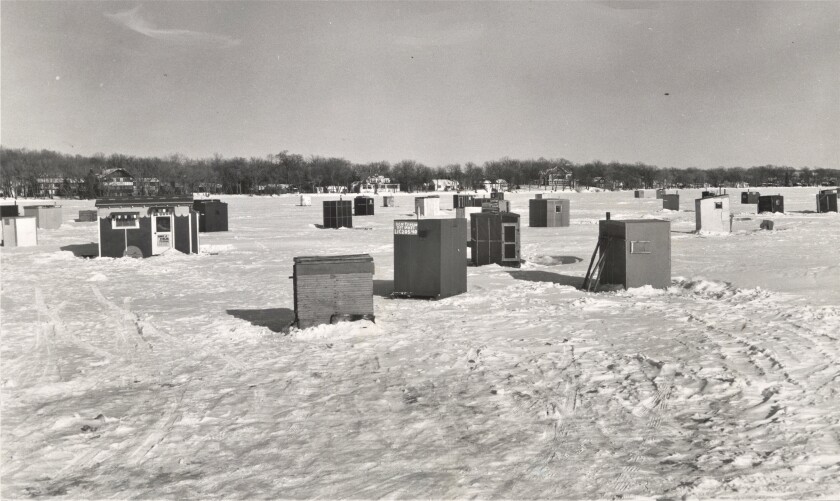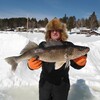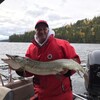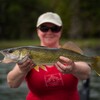The Fascinating History of Ice Fishing in the North

The (Very) Early Days
Long before ice fishing was considered a form of recreation, it was a matter of survival for the Indigenous communities across Ontario and the rest of Canada. With the long and extremely cold days of winter, fish caught through the ice were a critical source of nutrition. This is especially true for those living in Northern Ontario where there are a lot of lakes but not much arable land. Here fishing and hunting for food were mainstays of daily life.
In the northwestern part of what is now the province of Ontario, the Ojibwe were experts at ice fishing, using tools likely made from bone or stone to chip away and make holes in the ice. Spearfishing was the primary method of catching the fish lured to the holes with wooden decoys or bait. In some cases traps were built with bait inside and later, nets were employed.
Ice fishing was a communal activity where individuals and families cooperated and shared their catches. The tradition of ice fishing in these communities continues today.
Rods, Reels and Augers
Ice fishing took on a recreational character in the late 1800s when fishing rods and reels were first manufactured. The first ice auger patented in the USA was by William Clark in 1873, making the task of getting through the ice much easier. While the tools were extremely primitive compared to what's available today, they still worked and people began to fish on the ice in the winter just like they did out of a boat in the summer.

The first manufactured rods made specifically for ice fishing were usually made of wood, but more finely crafted and often, a stronger more flexible wood was used. Early reels involved a drum/barrel system with a handle and were made of metal. With the introduction of synthetic plastics, fishing line strength and durability improved, increasing anglers' success rates. The defining characteristic of early manufactured rods and reels was their appearance as something that was made-for-purpose and available to the public in stores across North America. Ice fishing as a sport had begun.

The Modern Era of Ice Fishing
As early as the late 1950s technology began to make an appearance with the first sonar devices called "flashers" being used. These new devices helped ice anglers not only see the fish come up to their bait, but even helped them see the fish strike.

With the formation of companies like Eskimo Ice Fishing Gear in Wisconsin in 1960, ice fishing took off as a great way to recreate and spend quality time in the outdoors during the winter. Eskimo revolutionized the ice auger making it a powered device that made even the thickest ice penetrable by anglers.
In Northwestern Ontario, ice fishing was becoming more popular as a winter recreational activity, something people did on their own with families and friends getting out on the ice and trying to catch dinner. Promoting ice fishing as a tourist activity was just beginning, as most cabins in the northwest were not winterized and the vast majority of tourists still came to fish in the summer months.

Also during the 1960s, the first ice fishing shelters appeared called "shanties" and were either portable wood or tent-like structures designed to get anglers out of the coldest winds. From there, making these shelters more comfortable was a constant objective, as was making them lighter and more mobile.
The 2000s: Comfort and Luxury Take Over
As the popularity of ice fishing grew from the 1970s through the 1990s, new innovations came quickly. Anglers enjoyed access to better lines, more durable rods and reels, and better shelters. Innovations in electronic ice-fishing technology also exploded during this time. More companies saw ice fishing as an opportunity to expand their product lines and the variety of equipment available to the public grew.

By the late 1990s and especially the first two decades of the 21st Century, technological advances and the search for a more comfortable ice fishing experience were the big developments. What is available today would astonish the ice anglers of the past.
The Big Push for Comfort
By 2015, the push for a better, more comfortable ice fishing experience led to the development of luxury ice houses. These beautiful units are like an RV but designed specifically for ice fishing. Pulled out onto the ice in winter, these structures offer every convenience—propane heated, a full fridge and stove, bunks for sleeping, and pre-cut holes from which you fish in complete comfort—in a t-shirt, if you want. By 2020, these ice houses became high-end luxurious vacation opportunities where it doesn't matter how cold it is outside, you could ice fish for days on end in a climate-controlled atmosphere. In Sunset Country you can book a trip in one from Lake of the Woods Ice Sleepers.
Here is a full list of businesses that offer ice-fishing packages in Northwestern Ontario.






Image courtesy of LOTW Ice Sleepers
We've Come A Long Way
In the past 100 years, ice fishing has become an activity people did for sustenance to one you do for fun. The luxury ice houses are leaps and bounds beyond those wood shanties that were little more than places to get out of the wind. With today's equipment, especially things like sonar and Mega Live, the fish are a lot easier to catch too.
Ice fishing in Northwestern Ontario is a bucket list trip—one you should definitely try!


Recommended Articles

Is the 1,400 Kilometre Drive to Northwest Ontario For a Fishing Trip Worth it?

8 must-see waterfalls

6 Ways to Get Your 10,000 Steps This Fall

Top 5 Reasons You Should Be Fishing in Morson, Ontario

Discover The Winnipeg River

Enjoy Sunset Country's Fall Colours on Your Next Road Trip

Fishing in the Fall?

6 Reasons to Book a Fall Vacation to Sunset Country

10 Reasons to Avoid Ontario’s Sunset Country

Heading Across Canada?

A Guide to Sunset Country Museums

The Promised Land: Best Muskie Fishing in Ontario

Fall Fishing Tips
5 Essential Boreal Experiences in Ontario's Sunset Country

5 Obscure Facts About Northwestern Ontario: Were You Aware of These?

Great Food in Relatively Unknown Places
Outdoor Medicine

A Guide to Bringing Your Pets on Vacation to Canada

There's more than just fishing in the Red Lake Region

5 Amazing Sights You Can Only See By Boat

Going Fishing in Canada?

Going fishing in Ontario?

Outdoor Adventure in Ontario's Northern Paradise
Planning A Family Fishing Trip to Canada

Tips from a Fishing Legend






























